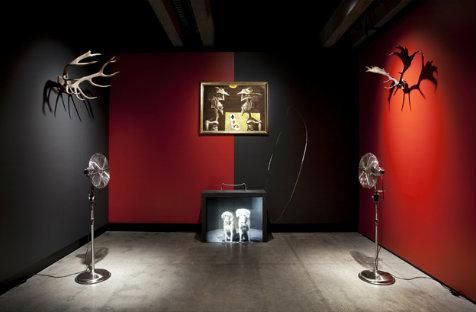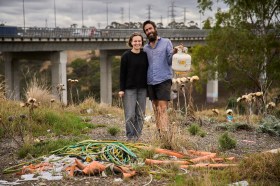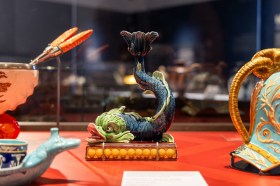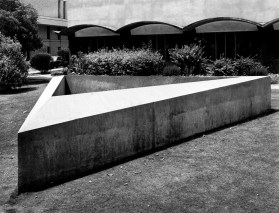Hobart’s Museum of Old and New Art (MONA) is shedding its reputation as the antipodean Adult Disneyland and the Museum of Sex and Death. Renowned French curator Jean-Hubert Martin has been granted ‘carte blanche’ by David Walsh to exploit both the MONA and Tasmanian Museum and Art Gallery (TMAG) archives to realise the current exhibition, Theatre of the World. The resulting show is a vision of material existence as a promiscuously ensouled yet unstable reality.
Walsh, despite his publicly known secular views, in the catalogue preface for Theatre of The World, declares a post-secular vision, with a sense of enchantment: ‘All things are one thing and that one thing is […] rich with a richness that makes all things grand.’
Theatre of the World’s historical muse is the Theatre of Memory by Renaissance esoteric, Giulio Camillo. Camillo’s unrealized theatre presented a quest for omniscience, charting and ciphering words, images and objects for the privileged initiate.
MONA’s Theatre of The World democratises Camillo’s project. Unlike the secrecy of esoterics and the rationalism of a scientific spirit, Martin eschews ‘abstract thought ordering matter’. He prefers the visitor to carefully see the world with the naturalness and immediacy of ‘visual thinking’. He likens this approach to the non-conformist studio experiments of artists.
Walsh, similarly exasperated by what he calls postmodern ‘artwank’, yearns for a fresh approach to engaging art with no bias, or ‘practiced method for seeking truth’ except ‘visual poetry’.
With over 400 objects spanning 4000 years, the difficulty appears to be how to encourage or to organise the visitor to suddenly exercise and sustain the poetics of ‘visual thinking’.
Is there something more than a poetic, decorative eye at work, or is there, despite Walsh’s conviction, a bias – like Camillo – for a desired goal in the Theatre? Arguably, yes, there is a method and a discernible goal. Martin has harvested ‘characteristic structures’ among disparate works as a cognitive and spiritual exercise by which to penetrate and see the theatre of the world.
Selectively wallpapered, carpeted, seated, illuminated, darkened, screened and partitioned into 20 discrete spaces by designers Adrian Spinks and Mattijs Visser, the sequence of rooms subdues the usual pedestrian free-float of touristic grazing. The design establishes a sequence and a story resplendent with cosmogonic mythos.
The exhibition begins with the theme of ‘the eyes’. Martin is interested in the way objects communicate with the viewer. This idea of visual rapport has an animist feel, a mindset usually dormant in the West. Room One, labelled ‘Scope’ shows an eclectic grouping of objects which survey spirit or being or Nature as ‘personhood’. Like Pierre Hadot’s study on the Heraclitean ‘Nature loves to Hide’, personhood is revealed as precious and vulnerable in the material hungering of the world.
Room One consequently portrays a universal human condition that reappears throughout the entire exhibition. The subsequent rooms explore the morphogenesis of desire and self knowledge with diverse metaphor and detail.
There is undeniably the richest, most exciting and complex constellation of objects in the exhibition. What is kept separate and distinct in the physical world is perforated and seen in oscillating continuum.
Martin consummates the erotic aesthetics of the main room with what appears as a Socratic spiritual exercise in cognitive breathing with two en suites. The first en suite contains the Kempinas O (between fans) that cognitively beholds the keys on the constitutive character of eroticism and the second, Juul Kraijer’s Inner Eye utilises the keys to be conveyed into a transpersonal realm – the very place Martin desires to transport you with his mode of enchantment.
Tucked away in a circular, dimly lit chamber, Shulman’s Candle Describing A Sphere (2006) consummates the spiritual exercise while being and revealing the hidden treasure of interior life This work comes closest to confirming Walsh’s ‘one thing’. Silently, the candle awaits, extraordinary, a luminous sphere, scaling, ebbing ‘elusively’ in proportion to the viewer’s changing proximity. Martin has casually suggested that the firmament represents ‘the soul’ or, ‘halo’ but it also recalls Camillo’s pivotally charted intellectus agens; the conduit between divine intellect and perception of the ordinary. Or, as the outside adjacent work, Samuel Beckett’s Comédie (1966) indicates, the luminous orb demonstrates logos as the harmony enduring both the tension and eroticism of opposites.
Theatre of the World reveals a peculiar post-secular enchantment, which Martin and Walsh appear to desire as a response to Camillo’s ‘Theatre’, a remedy to the prosaic ‘disenchantment[s]’ of the present age.
Rating: 4 ½ stars out of 5
The Theatre of the World
Curated by Jean-Hubert Martin
Museum of Old and New Art, Hobart
23 July 2012 – 8 April 2013





